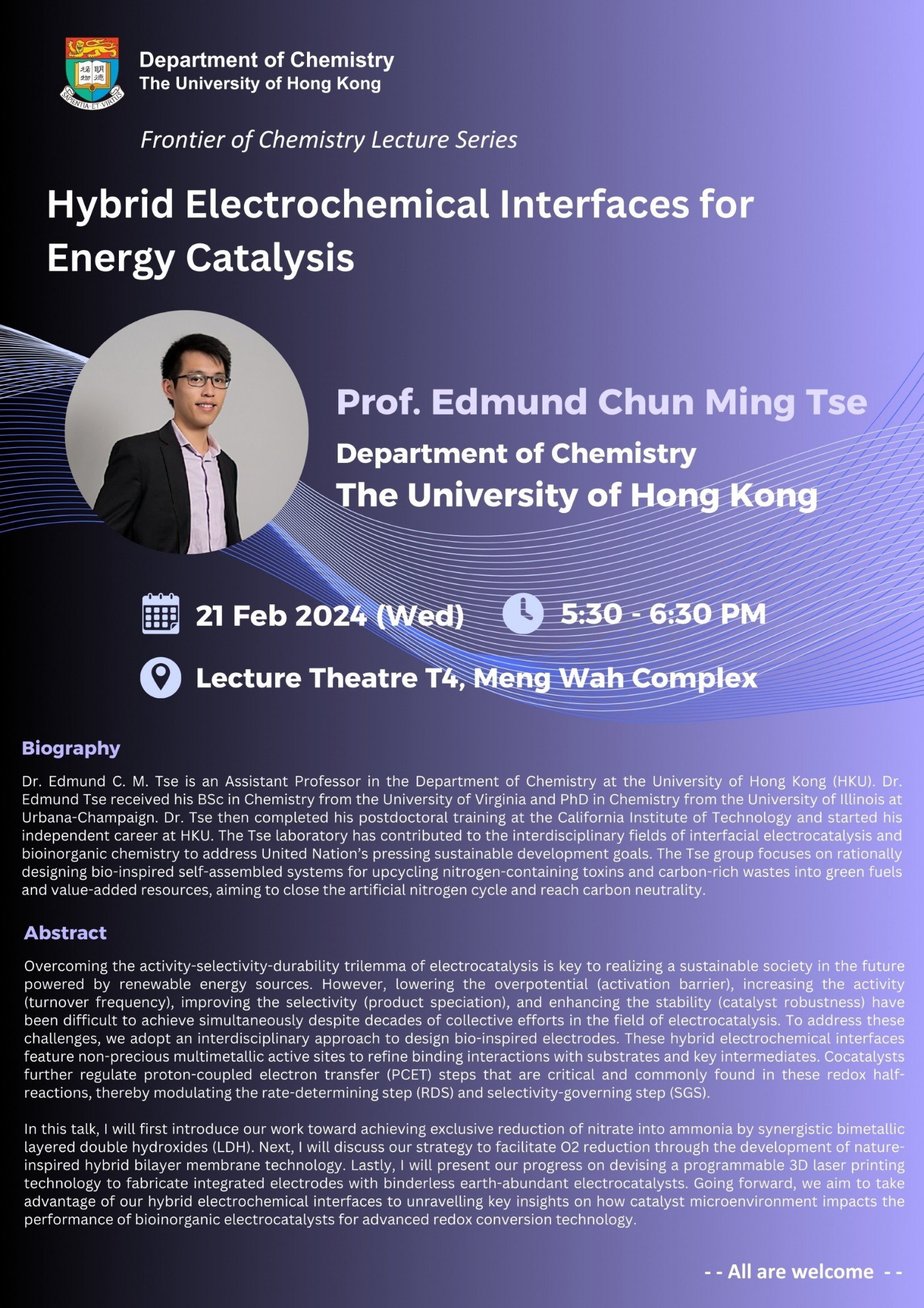| Date | 21 Feb 2024 |
| Time | 5:30 - 6:30 PM (HKT) |
| Venue | Lecture theatre T4, Ming Wah Complex |
| Speaker | Prof. Edmund Chun Ming Tse |
| Institution | Department of Chemistry, The University of Hong Kong |
 Title:
Title:
Hybrid Electrochemical Interfaces for Energy Catalysis
Schedule:
Date: 21st February, 2024 (Wednesday)
Time: 5:30 - 6:30 pm (HKT)
Venue: Lecture Theatre T4, Meng Wah Complex
Speaker:
Prof. Edmund Chun Ming Tse
Department of Chemistry
The University of Hong Kong
Biography:
Dr. Edmund C. M. Tse is an Assistant Professor in the Department of Chemistry at the University of Hong Kong (HKU). Dr. Edmund Tse received his BSc in Chemistry from the University of Virginia and PhD in Chemistry from the University of Illinois at Urbana-Champaign. Dr. Tse then completed his postdoctoral training at the California Institute of Technology and started his independent career at HKU. The Tse laboratory has contributed to the interdisciplinary fields of interfacial electrocatalysis and bioinorganic chemistry to address United Nation’s pressing sustainable development goals. The Tse group focuses on rationally designing bio-inspired self-assembled systems for upcycling nitrogen-containing toxins and carbon-rich wastes into green fuels and value-added resources, aiming to close the artificial nitrogen cycle and reach carbon neutrality.
Abstract:
Overcoming the activity-selectivity-durability trilemma of electrocatalysis is key to realizing a sustainable society in the future powered by renewable energy sources. However, lowering the overpotential (activation barrier), increasing the activity (turnover frequency), improving the selectivity (product speciation), and enhancing the stability (catalyst robustness) have been difficult to achieve simultaneously despite decades of collective efforts in the field of electrocatalysis. To address these challenges, we adopt an interdisciplinary approach to design bio-inspired electrodes. These hybrid electrochemical interfaces feature non-precious multimetallic active sites to refine binding interactions with substrates and key intermediates. Cocatalysts further regulate proton-coupled electron transfer (PCET) steps that are critical and commonly found in these redox half-reactions, thereby modulating the rate-determining step (RDS) and selectivity-governing step (SGS).
In this talk, I will first introduce our work toward achieving exclusive reduction of nitrate into ammonia by synergistic bimetallic layered double hydroxides (LDH). Next, I will discuss our strategy to facilitate O2 reduction through the development of nature-inspired hybrid bilayer membrane technology. Lastly, I will present our progress on devising a programmable 3D laser printing technology to fabricate integrated electrodes with binderless earth-abundant electrocatalysts. Going forward, we aim to take advantage of our hybrid electrochemical interfaces to unravelling key insights on how catalyst microenvironment impacts the performance of bioinorganic electrocatalysts for advanced redox conversion technology.
- ALL ARE WELCOME -
